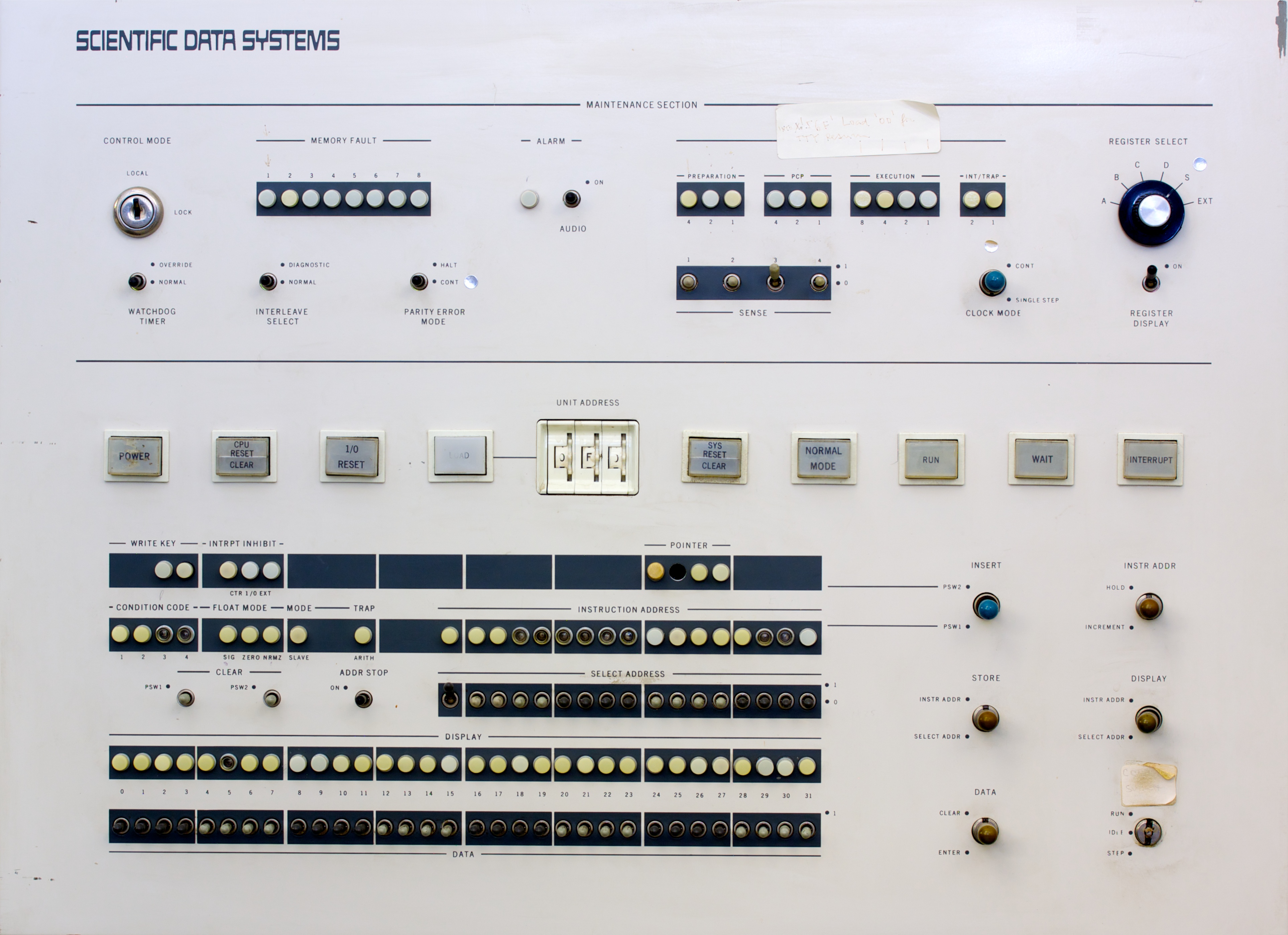|
Honeywell CP-6
CP-6 is a discontinued computer operating system, developed by Honeywell, Inc. in 1976, which was a backward-compatible work-alike of the Xerox CP-V fully rewritten for Honeywell Level/66 hardware. CP-6 was a command line oriented system. A terminal emulator allowed use of PCs as CP-6 terminals. History In 1975, Xerox decided to sell the computer business which it had purchased from Scientific Data Systems in 1969. In a deal put together by Harry Sweatt, Honeywell purchased Xerox Data Systems, and took on the Xerox sales and field computer support staff to provide field service support to the existing customer base. Xerox made available all the spare equipment and supplies and the warehouses containing them. Revenues were shared 60/40 Xerox until CP-6 General Release, and 60/40 Honeywell for three years thereafter. Following that all revenue went to Honeywell. In the early 1960s, Honeywell had built and sold a large number of H200 machines, together with software. In 1970 ... [...More Info...] [...Related Items...] OR: [Wikipedia] [Google] [Baidu] |
Xerox
Xerox Holdings Corporation (; also known simply as Xerox) is an American corporation that sells print and electronic document, digital document products and services in more than 160 countries. Xerox is headquartered in Norwalk, Connecticut (having moved from Stamford, Connecticut, in October 2007), though it is incorporated in New York (state), New York with its largest population of employees based around Rochester, New York, the area in which the company was founded. The company purchased Affiliated Computer Services for $6.4 billion in early 2010. As a large developed company, it is consistently placed in the list of Fortune 500 companies. On December 31, 2016, Xerox separated its business process service operations, essentially those operations acquired with the purchase of Affiliated Computer Services, into a new publicly traded company, Conduent. Xerox focuses on its document technology and document outsourcing business, and traded on the NYSE from 1961 to 2021, and the N ... [...More Info...] [...Related Items...] OR: [Wikipedia] [Google] [Baidu] |
SPSS
SPSS Statistics is a statistical software suite developed by IBM for data management, advanced analytics, multivariate analysis, business intelligence, and criminal investigation. Long produced by SPSS Inc., it was acquired by IBM in 2009. Current versions (post 2015) have the brand name: IBM SPSS Statistics. The software name originally stood for Statistical Package for the Social Sciences (SPSS), reflecting the original market, then later changed to Statistical Product and Service Solutions. Overview SPSS is a widely used program for statistical analysis in social science. It is also used by market researchers, health researchers, survey companies, government, education researchers, marketing organizations, data miners, and others. The original SPSS manual (Nie, Bent & Hull, 1970) has been described as one of "sociology's most influential books" for allowing ordinary researchers to do their own statistical analysis. In addition to statistical analysis, data management (ca ... [...More Info...] [...Related Items...] OR: [Wikipedia] [Google] [Baidu] |
Lisp (programming Language)
Lisp (historically LISP) is a family of programming languages with a long history and a distinctive, fully parenthesized prefix notation. Originally specified in 1960, Lisp is the second-oldest high-level programming language still in common use, after Fortran. Lisp has changed since its early days, and many dialects have existed over its history. Today, the best-known general-purpose Lisp dialects are Common Lisp, Scheme, Racket and Clojure. Lisp was originally created as a practical mathematical notation for computer programs, influenced by (though not originally derived from) the notation of Alonzo Church's lambda calculus. It quickly became a favored programming language for artificial intelligence (AI) research. As one of the earliest programming languages, Lisp pioneered many ideas in computer science, including tree data structures, automatic storage management, dynamic typing, conditionals, higher-order functions, recursion, the self-hosting compiler, and the read†... [...More Info...] [...Related Items...] OR: [Wikipedia] [Google] [Baidu] |
SNOBOL
SNOBOL ("StriNg Oriented and symBOlic Language") is a series of programming languages developed between 1962 and 1967 at AT&T Bell Laboratories by David J. Farber, Ralph E. Griswold and Ivan P. Polonsky, culminating in SNOBOL4. It was one of a number of text-string-oriented languages developed during the 1950s and 1960s; others included COMIT and TRAC. SNOBOL4 stands apart from most programming languages of its era by having patterns as a first-class data type (''i.e.'' a data type whose values can be manipulated in all ways permitted to any other data type in the programming language) and by providing operators for pattern concatenation and alternation. SNOBOL4 patterns are a type of object and admit various manipulations, much like later object-oriented languages such as JavaScript whose patterns are known as regular expressions. In addition SNOBOL4 strings generated during execution can be treated as programs and either interpreted or compiled and executed (as in the eval ... [...More Info...] [...Related Items...] OR: [Wikipedia] [Google] [Baidu] |
Pascal (programming Language)
Pascal is an imperative and procedural programming language, designed by Niklaus Wirth as a small, efficient language intended to encourage good programming practices using structured programming and data structuring. It is named in honour of the French mathematician, philosopher and physicist Blaise Pascal. Pascal was developed on the pattern of the ALGOL 60 language. Wirth was involved in the process to improve the language as part of the ALGOL X efforts and proposed a version named ALGOL W. This was not accepted, and the ALGOL X process bogged down. In 1968, Wirth decided to abandon the ALGOL X process and further improve ALGOL W, releasing this as Pascal in 1970. On top of ALGOL's scalars and arrays, Pascal enables defining complex datatypes and building dynamic and recursive data structures such as lists, trees and graphs. Pascal has strong typing on all objects, which means that one type of data cannot be converted to or interpreted as another without explicit conversi ... [...More Info...] [...Related Items...] OR: [Wikipedia] [Google] [Baidu] |
SDS Sigma Series
The SDS Sigma series is a series of third generation computers that were introduced by Scientific Data Systems of the United States in 1966. The first machines in the series are the 16-bit Sigma 2 and the 32-bit Sigma 7; the Sigma 7 was the first 32-bit computer released by SDS. At the time the only competition for the Sigma 7 was the IBM 360. Memory size increments for all SDS/XDS/Xerox computers are stated in kWords, not kBytes. For example, the Sigma 5 base memory is 16K 32-Bit words (64K Bytes). Maximum memory is limited by the length of the instruction address field of 17 bits, or 128K Words (512K Bytes). Although this is a trivial amount of memory in today's technology, Sigma systems performed their tasks exceptionally well, and few were deployed with, or needed, the maximum 128K Word memory size. The Xerox 500 series computers, introduced starting in 1973, are compatible upgrades to the Sigma systems using newer technology. In 1975 Xerox sold its computer business to ... [...More Info...] [...Related Items...] OR: [Wikipedia] [Google] [Baidu] |
Timesharing
In computing, time-sharing is the sharing of a computing resource among many users at the same time by means of multiprogramming and multi-tasking.DEC Timesharing (1965), by Peter Clark, The DEC Professional, Volume 1, Number 1 Its emergence as the prominent model of computing in the 1970s represented a major technological shift in the history of computing. By allowing many users to interact concurrently with a single computer, time-sharing dramatically lowered the cost of providing computing capability, made it possible for individuals and organizations to use a computer without owning one, and promoted the interactive use of computers and the development of new interactive applications. History Batch processing The earliest computers were extremely expensive devices, and very slow in comparison to later models. Machines were typically dedicated to a particular set of tasks and operated by control panels, the operator manually entering small programs via switches in order ... [...More Info...] [...Related Items...] OR: [Wikipedia] [Google] [Baidu] |
Comshare
Geac Computer Corporation, Ltd ( and ) was a producer of enterprise resource planning, performance management, and industry specific software based in Markham, Ontario. It was acquired by Golden Gate Capital's Infor unit in March 2006 for US$1 billion. History Geac was incorporated in March 1971 by Robert Kurt Isserstedt and Robert Angus ("Gus") German. Geac started with a contract with the Simcoe County Board of Education to supply onsite accounting and student scheduling. They programmed inexpensive minicomputers to perform tasks that were traditionally done by expensive mainframe computers. Hardware/software Geac designed additional hardware to support multiple simultaneous terminal connections, and with Dr Michael R Sweet developed its own operating system (named ''Geac'') and own programming language (OPL) resulting in a multi-user real-time solution called the Geac 500. The initial implementation of this system at Donlands Dairy in Toronto led to a contract at Vancouve ... [...More Info...] [...Related Items...] OR: [Wikipedia] [Google] [Baidu] |
Carleton University
Carleton University is an English-language public research university in Ottawa, Ontario, Canada. Founded in 1942 as Carleton College, the institution originally operated as a private, non-denominational evening college to serve returning World War II veterans. Carleton was chartered as a university by the provincial government in 1952 through ''The Carleton University Act,'' which was then amended in 1957, giving the institution its current name. The university is named for the now-dissolved Carleton County, which included the city of Ottawa at the time the university was founded. Carleton County, in turn, was named in honour of Guy Carleton, 1st Baron Dorchester, who was Governor General of The Canadas from 1786 to 1796. The university moved to its current campus in 1959, growing rapidly in size during the 1960s as the Ontario government increased support for post-secondary institutions and expanded access to higher education. Carleton offers a diverse range of academic program ... [...More Info...] [...Related Items...] OR: [Wikipedia] [Google] [Baidu] |
General Electric
General Electric Company (GE) is an American multinational conglomerate founded in 1892, and incorporated in New York state and headquartered in Boston. The company operated in sectors including healthcare, aviation, power, renewable energy, digital industry, additive manufacturing and venture capital and finance, but has since divested from several areas, now primarily consisting of the first four segments. In 2020, GE ranked among the Fortune 500 as the 33rd largest firm in the United States by gross revenue. In 2011, GE ranked among the Fortune 20 as the 14th most profitable company, but later very severely underperformed the market (by about 75%) as its profitability collapsed. Two employees of GE – Irving Langmuir (1932) and Ivar Giaever (1973) – have been awarded the Nobel Prize. On November 9, 2021, the company announced it would divide itself into three investment-grade public companies. On July 18, 2022, GE unveiled the brand names of the companies it will ... [...More Info...] [...Related Items...] OR: [Wikipedia] [Google] [Baidu] |
Honeywell 200
The Honeywell 200 was a character-oriented two-address commercial computer introduced by Honeywell in December 1963, the basis of later models in Honeywell 200 Series, including 1200, 1250, 2200, 3200, 4200 and others, and the character processor of the Honeywell 8200 (1968). Introduced to compete with IBM's 1401, the H200 was two or three times faster and, with software support, most of the time could execute IBM 1401 programs without need for their recompilation or reassembly. The Liberator marketing campaign exploited this compatibility, and was credited in later Honeywell publicity statements with stalling the sales of IBM 1401 machines. Honeywell claimed an initial rush of hundreds of orders for the H200 that itself stalled when IBM countered with a marketing emphasis on their System 360 product range that was then under development. Architecture As designed by Director of Engineering William L. Gordon, the H200 memory consisted of individually addressed characters, eac ... [...More Info...] [...Related Items...] OR: [Wikipedia] [Google] [Baidu] |



